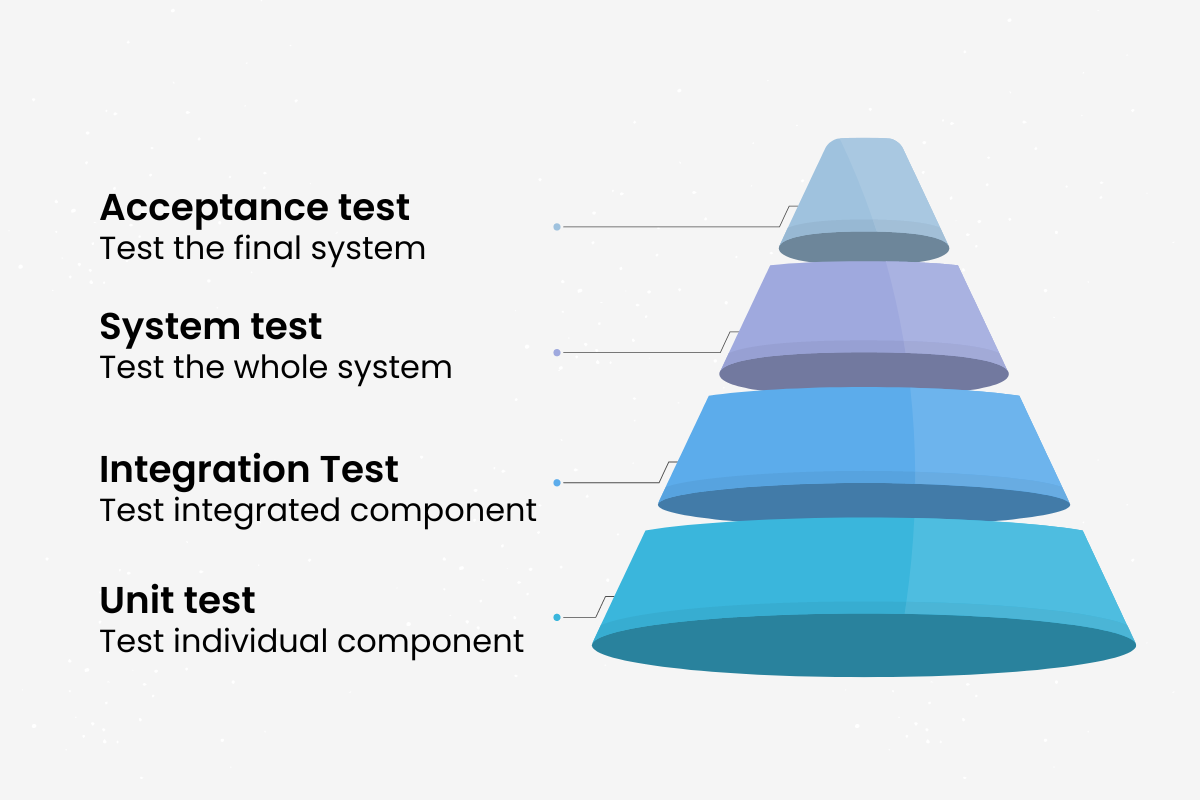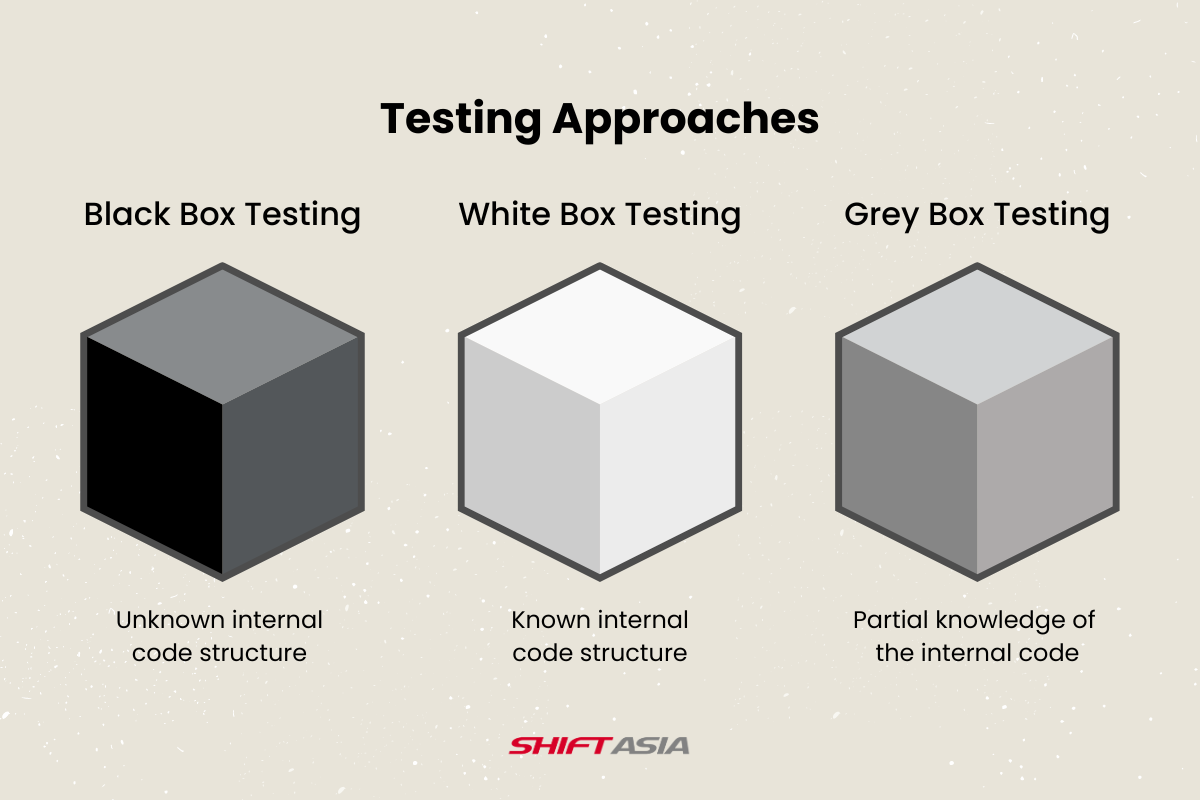Software testing is not just about finding bugs; it’s a systematic process of validating that the software works as intended, meets user expectations, and aligns with business requirements. Whether it’s a small mobile app or a complex enterprise system, rigorous testing is essential to maintaining quality, reducing risks, and enhancing user satisfaction.
As software systems become more complex, the importance of effective testing grows. Poorly tested software can lead to financial losses, legal repercussions, and even user harm. For example, a glitch in a financial application could result in incorrect transactions, while a flaw in a healthcare system might jeopardize patient safety. The stakes are high, and testing is the safety net that ensures such failures are avoided.
This guide will explore software testing fundamentals, including key concepts, methodologies, and best practices.
What are the fundamentals of software testing?
At its core, software testing is an important process for ensuring that software products and systems function as expected and discovering and fixing defects. In recent years, the importance of software testing has increased as development projects have become larger and more complex.
The need for Software testing
The primary reason for software testing is to ensure the quality of the final product and build user trust by finding and fixing bugs and defects early. According to CISQ, poor software cost the U.S. economy $2.08 trillion in 2020 alone, making testing a vital tool for reducing risk and improving quality. Testing allows potential issues to be spotted before a product is released, reducing the time and cost of fixing them.
In short, Software testing ensures that systems are:
- Reliable: Performing under specified conditions.
- Functional: Meeting business and user requirements.
- Secure: Protecting data and operations from vulnerabilities.
The Role of Testing
Software testing is integral to the development process and ensures that the final product meets the desired quality standards and user expectations. Its objectives can be categorized into multiple dimensions, each focusing on a specific aspect of software performance and reliability:
Ensuring functionality:
One of the primary objectives is to verify that the software functions according to the defined requirements. This includes:
- Checking that features and components work as intended.
- Validating that workflows and user interactions are seamless and logical.
- Ensuring that the software behaves correctly under different scenarios, including edge cases.
Enhancing quality:
Testing aims to improve the overall quality of the product by identifying issues early in the development lifecycle. A high-quality product is:
- Reliable: Free from critical bugs or crashes.
- Maintainable: Easy to update and extend in the future.
- Usable: Delivering a positive user experience.
Identifying and fixing defects:
A key goal of testing is to uncover bugs or defects before the software is deployed. This includes:
- Spotting coding errors that impact functionality.
- Detecting performance bottlenecks, such as slow response times or memory leaks.
- Identifying security vulnerabilities that could compromise user data.
Validating business and user needs:
Testing ensures that the software aligns with business objectives and meets end-user expectations by:
- Verifying that features address user pain points.
- Ensuring compliance with industry standards and legal requirements.
- Delivering a product that achieves its intended purpose effectively.
Reducing risks:
Testing minimizes the risks associated with software failures, such as:
- Financial Losses: Avoid downtime or errors that could disrupt operations.
- Reputation Damage: Prevent negative publicity caused by poor software performance.
- Legal Liabilities: Ensure compliance with regulations to avoid penalties.
Supporting maintenance and scalability:
Comprehensive testing lays the foundation for long-term product success by:
- Ensuring that the software can scale to handle increased loads or additional features.
- Providing a stable and defect-free codebase for future updates or enhancements.
Promoting efficiency and cost savings:
Testing helps identify issues early, which reduces the cost and effort required to fix them later. The earlier a defect is found, the less expensive it is to resolve.
Performance validation:
Testing also ensures that the software performs optimally under various conditions by:
- Verifying speed, responsiveness, and stability under normal and stress conditions.
- Ensuring that the software can handle multiple users or large datasets without degradation.
Building confidence in the product:
A well-tested product builds trust among stakeholders, including developers, testers, end-users, and clients, by:
- Demonstrating that the software is ready for release.
- Reducing uncertainty about its performance in real-world scenarios.
Continuous improvement:
Testing contributes to the iterative enhancement of the development process by:
- Providing insights into common defects and their root causes.
- Guiding teams in refining their methodologies and best practices.
The role of testing goes beyond bug fixing. It ensures product quality and provides developers with feedback to improve the product. Testing is also extremely beneficial for business. According to a Capgemini survey, 85% of organizations can directly improve customer satisfaction through software testing. Testing also evaluates project progress and provides transparency to customers and stakeholders. In this way, testing is the safety net of software development and a key factor in business success.
Main types of tests
There are several main types of software testing. Each type is performed in different phases and has a specific goal, which is essential to improving the quality of the software. Let’s take a closer look at each type of testing, its purpose, and who performs it.

Unit Testing
Unit testing is one of the most basic yet essential types of testing in the software development process. Typically performed by developers, it verifies whether individual features or components work as expected. Unit testing examples include whether a calculation function produces the correct result or whether input field validation works properly.
Unit testing helps identify defects early in the development process. It is commonly performed regularly to ensure that changes in the code do not negatively impact other areas. Additionally, unit testing enhances code quality by simplifying the refactoring process, ultimately leading to better code maintainability.
Integration Testing
Integration testing is critical to ensure that multiple components work together correctly. Developers or specialized testers usually perform it to check the accuracy of interfaces and data flow. For example, it tests whether the user authentication system works correctly with the database and whether expected permissions are applied.
Integration testing can be done using different integration strategies: top-down, bottom-up, big bang, etc. The Big Bang strategy works well for small projects, but the complexity increases for larger projects, and it is usually recommended to do it step by step.
System Testing
System testing is used to verify the operation of the entire, fully integrated software system, typically performed by an independent testing team, focusing on functional requirements, performance, security, and usability, simulating the environment in which users will use the system.
System testing uses various techniques, such as load, stress, security, etc. Load testing simulates scenarios in which many users access the system at one time.
Acceptance Testing
Acceptance testing is the final phase of testing, during which clients or end users are allowed to ensure that the software works as expected in a live production environment. Successful testing gives confidence that the software meets business needs, and it is usually conducted through user acceptance testing (UAT).
The main types of acceptance testing are alpha testing and beta testing. Alpha testing is done in a developer environment, while beta testing is done in a production environment with real users. Feedback from this final stage allows further tweaks and improvements to be made.
All these tests work together to establish a solid foundation for the successful delivery of the software to both the market and users. Effective planning and execution of each testing phase enhance the project’s overall success.
When do we perform software testing?
Software testing is not a one-time event. In modern software development, testing is not confined to a specific phase but is integrated throughout the development lifecycle. With the adoption of Continuous Integration and Continuous Deployment (CI/CD) pipelines, testing has become a continuous, iterative process that ensures high-quality software delivery at every stage.
During Development (Shift-Left Testing)
Testing begins during the early stages of development to identify and fix defects as soon as possible. This is called Shift-Left Testing, where testing is moved closer to the initial development stages. It includes:
- Unit Testing: Developers test individual components or modules immediately after writing code.
- Static Code Analysis: Automated tools analyze code quality and enforce coding standards.
During Integration
Integration testing ensures that different modules or components work together seamlessly as they are integrated. Focus is placed on communication between APIs, databases, and third-party services. This stage ensures that no conflicts arise when combining various components.
During System Development
When the entire system is assembled, System Testing verifies the end-to-end functionality. This is crucial for validating the application as a whole.
During Deployment Preparation
Before releasing the software, Acceptance Testing ensures the product meets business requirements and user expectations. Regression Testing checks that new features or fixes haven’t negatively impacted existing functionality. Performance testing and Load Testing evaluates the software’s behavior under expected and peak usage conditions.
During Continuous Integration/Deployment (CI/CD)
In CI/CD pipelines, testing is integrated as an automated process that runs at every pipeline stage. This includes:
- Build Verification Testing: Ensures the codebase builds correctly after new commits.
- Automated Unit and Integration Testing: Runs a suite of tests to catch errors early in the pipeline.
- Regression Testing: Ensures recent changes do not break existing functionality.
- End-to-End (E2E) Testing: Simulates real user flows to validate system-wide functionality.
The CI/CD process ensures quick feedback, allowing teams to detect and resolve issues before they reach production.
Post-Deployment Testing (Shift-Right Testing)
Once the software is deployed, testing doesn’t stop. Shift-Right Testing focuses on monitoring and validating the application in production environments. This includes:
- Real-User Monitoring (RUM): Observing user interactions to identify real-time issues.
- A/B Testing: Experimenting with features to determine user preferences.
- Post-Release Regression Testing: Verifies that recent changes are stable in the production environment.
Continuous Testing in DevOps
In the context of DevOps, testing is integrated across all stages of the development lifecycle. It emphasizes:
- Automation: Replacing manual processes with automated tests to save time and effort.
- Collaboration: Bridging gaps between development, QA, and operations teams to ensure consistent quality.
- Feedback Loops: Rapid feedback from automated tests helps developers make quick adjustments.
The Importance of Testing in CI/CD
Integrating testing into the CI/CD pipeline offers numerous advantages:
- Faster Time-to-Market: Automated tests allow quicker releases without compromising quality.
- Reduced Costs: Early detection of defects minimizes the cost of fixes.
- Improved Reliability: Continuous testing ensures stability even with frequent updates.
- Scalability: Testing frameworks can handle the growing complexity of software systems.
Software testing is a continuous activity embedded throughout the software development lifecycle. Leveraging CI/CD practices ensures that testing is fast, efficient, and adaptive to modern development, ultimately resulting in robust, high-quality software.
Introduction to Testing Methodology

Software testing methodologies are essential to successful quality assurance. This chapter provides an in-depth look at the major testing methodologies. Understanding white box, black box, and gray box testing techniques will help you develop and manage an appropriate testing strategy.
White Box Testing
White box testing is a methodology that allows for detailed test coverage by understanding the software’s internal structure and operation. This testing methodology directly examines a program’s source code and evaluates the completeness of the code logic. Specifically, it is an effective method for discovering unintended defects and logical errors.
Black Box Testing
Black box testing is a method of testing software functionality and behavior from the outside. It evaluates the system’s response and functionality from a user’s perspective. It focuses primarily on inputs and outputs to ensure the system responds as expected. This technique is very useful for evaluating user experience and fulfilling specifications.
Black box testing is especially used in large software system testing and acceptance testing.
Grey Box Testing
Gray box testing is a combination of white box and black box testing techniques. It is a testing method that requires partial internal knowledge of the software under test. Understanding the internal structure, to a certain extent, allows verification through external input and output. It is particularly effective in testing complex systems and integration scenarios and is widely adopted by companies.
Gray box testing is helpful for finding errors that may be overlooked in black box testing and shortening scenarios that take time to execute in white box testing.
Software Testing Process
Software testing is a structured and methodical activity that identifies defects and ensures that the software meets specified requirements. A well-defined testing process is critical to achieving these objectives. Below is a breakdown of the key steps involved in the software testing process.
Planning and Design
The first step is planning and designing. In this stage, a test plan is formulated using development cycles such as the Agile model. A deep understanding of the system requirements is gained, and it is clarified what kind of tests are required and their purpose.
- Requirement analysis: An in-depth analysis of the system requirements to be tested is performed to determine the extent of testing required.
- Developing a test plan: Define the specific testing objectives, scope, methodologies to be used, and resources required.
Creating Test Cases
Writing test cases is a key element in the testing process. Each test case is written in detail to evaluate a specific functionality or system behavior. For example, a test case for a user registration functionality might include validating username, password entry, and any error messages.
Setting up the test environment
Next, prepare the test environment, which is essential to ensure that the tests are as close as possible to real-world conditions. Using IEEE standards as a guide, prepare the environment, including the required hardware, software components, and network settings.
Test Execution and Reporting
The actual test execution is carried out according to the plan. It is important to record the test results accurately and analyze them regularly. The test report includes details of each successful and failed test. If any problems are found, the information is reported in detail. It is beneficial to hold regular sprint reviews to share the current progress and problems with the whole team.
Throughout every step, we identify areas for improvement in the software and, if necessary, perform regression testing to ensure that early bugs and errors are fixed, resulting in higher-quality working software.
Through these processes, we can dramatically improve the success rate of test projects and maximize software quality.
Testing Tools and Techniques
It is important to use the right tools and techniques to perform software testing effectively. This section provides a detailed explanation of the main tools and techniques used to streamline the testing process and find bugs and defects early. The tools introduced here are industry standards, and examples of their use in actual development projects are included, along with specific usage and benefits.
Automation with Selenium
Selenium is the most widely used open-source framework for automating web application testing, especially with the wide range of browsers it supports and the ability to create test scripts in a variety of programming languages.
For example, using Selenium to automate repetitive tasks such as logging in to an e-commerce site, searching for products, and adding them to a cart can significantly reduce the amount of manual testing required.
Test Management with JIRA
JIRA is used by many development teams around the world as a project management tool that supports agile development. In particular, it is attractive that you can centrally manage everything from test planning to execution and result recording by using a plugin such as Test Management for JIRA.
By using JIRA, you can efficiently create test cases and manage test progress, which is often overlooked in the early stages of a development project. This will improve the quality of the entire project.
Continuous Integration with Jenkins
Jenkins is an open-source automation tool that specializes in CI/CD (continuous integration/continuous delivery) to make the software development process smoother.
For example, you can set up tests to run automatically every time code is pushed to your repository, giving developers instant feedback so they can fix bugs sooner.
To maximize Jenkins’s effectiveness, detailed operational design, such as script version control and appropriate job division, is essential.
Software Testing Best Practices
Software testing is a critical component of quality assurance in software development and is key to the success of any project. To ensure success, it is recommended to follow some best practices:
The Importance of Documentation
Detailed documentation is the most important factor in ensuring that the whole team works from a common understanding. It should be in the form of concrete specifications, STRs, STDs, bug reports, etc. In this way, everyone in the project can be on the same page, and the testing efficiency can be improved. Detailed guidelines and standards can help to detect all potential problems.
Periodic testing
Regular testing is essential since software development environments and situations are constantly changing. Using a continuous integration (CI) system allows for efficient testing, enabling frequent updates and early detection of problems. In particular, tools such as Jenkins and CircleCI establish an automated test flow, allowing for quick bug detection and correction.
Using feedback loops
Leveraging feedback loops in project management is crucial to improving the software testing process. Feedback is collected at each project stage, and QA and development teams work together to adjust the process. Rapid feedback results in a higher-quality product and reduces development time and costs.
How can SHIFT ASIA help with software testing outsourcing services?
Effective software testing is essential for delivering reliable, high-quality applications. Businesses can mitigate risks and ensure user satisfaction by implementing robust testing processes, leveraging the right tools and methodologies, and adhering to best practices.
SHIFT ASIA takes this commitment to the next level, offering expert software testing outsourcing services designed to meet your specific needs. From functional and non-functional testing to CI/CD integration and beyond, SHIFT ASIA ensures your software achieves the highest quality standards, enabling you to focus on innovation and growth.
With the right partner, testing becomes a safeguard and strategic advantage. Ready to elevate your software quality and streamline your development process? Let SHIFT ASIA be the driving force behind your success.
ContactContact
Stay in touch with Us




